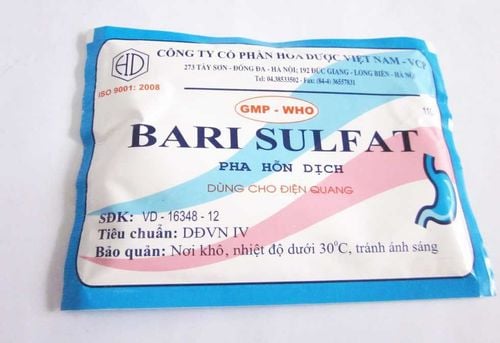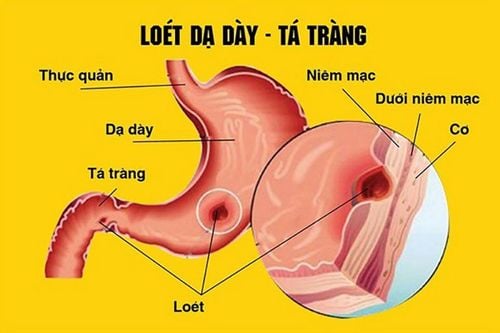This is an automatically translated article.
X-neurectomy is surgery to remove the conduction structure and dominant function of the X nerve. Indications for X-neurectomy are applied in the treatment of gastric ulcer, duodenal ulcer, pyloric stenosis,...1. Anatomy of the Nerve X
The X nerve, also known as the vagus nerve, is a mixed nerve with motor and sensory effects for the organs in the neck, chest, and abdomen. In the abdomen, the 10th nerve branches into the stomach for 60%, the liver for 10%, and other organs for 30%. In the thoracic region, two X nerves are located on either side of the esophagus, so they are called the left X nerve and the right X nerve. Down the abdomen due to the rotation of the stomach, so the left X nerve running forward is called the anterior X nerve, the right X nerve running behind the esophagus is called the posterior X nerve.1.1 Anterior X nerve According to Griffith, the anterior X nerve passes through the esophageal foramen by one fiber in 68%, two fibers in 30%, and three fibers in 2%. E.John found that 91% of the anterior cranial nerve trunks were located to the right of the midline of the esophagus. In the abdominal esophagus, the anterior X nerve is attached to the esophagus by the anteriorly wrapped peritoneal leaf, unlike the posterior X nerve, which is located in a loose layer of extraperitoneal tissue that easily separates from the esophagus.
Anterior X nerve usually has 3 branches including:
Hepatic branches: are separated from the right border of the anterior X nerve, starting from the cardia in the thick part of the lesser omentum to the hilum of the liver. Before reaching the liver, they separate into small fibers that govern the end of the antrum, pylorus, and duodenum. Anterior gastroesophageal plexuses: These branches are separated from the left border of the anterior X nerve in the abdominal esophagus or from above through the descending esophageal foramen. Anterior Latarjet major nerve branches: It is the terminal portion of the anterior X nerve that runs along the lesser curvature to the lesser curvature that divides into goose-like beams. The uppermost branch of this group has an ascending branch called Hedenstedt's recurrent branch, which is easily missed during superselective X-neurectomy. 1.2 Posterior X nerve Unlike the anterior X nerve, most of the posterior tenth nerve passes through the foramen of the diaphragm by a single fiber. Posterior X nerve has branches:
Visceral branch: is separated from the right border and runs into the positive plexus. This branch and the posterior main branch of Latarjet together with the sickle of the coronary artery form Jackson's triangle, an important landmark in selective X-neurectomy. The posterior major nerve branch of Latarjet: is the terminal segment of the posterior X nerve, runs in the same direction as the anterior main branch and terminates posteriorly in the body region by gooseleg branches.

Dây thần kinh số 10 là dây hỗn hợp có tác dụng vận động và cảm giác cho các tạng ở cổ, ngực và bụng.
2. Indications to cut the cranial nerve X
X-neurectomy or vagus nerve ablation is surgery to completely remove the conduction structure and dominant function of the vagus nerve when the nerve stem enters the abdomen through the diaphragmatic foramen in order to reduce secretions. gastric acid juice in the treatment of peptic ulcer disease. Selective neurectomy is surgery to cut the conduction structure and dominant function of the branches and trunk of the anterior X nerve entering the stomach after the hepatic branch of the anterior tenth nerve, cutting the branch and the cranial nerve. The posterior X nerve enters the stomach after the visceral branch of the posterior X nerve. Super-selective X-neurectomy is to cut only the branches of the anterior and posterior X nerves that supply the stomach's aneurysm, leaving branches of the antrum of the antrum.
2.1 Gastric ulcer Indications to cut the X nerve for gastric ulcer disease. Hedenstedt (1969) reported 32 cases of super-selective vagus nerve resection with good results. Johnston followed up with 14 patients for 3 years and did not find recurrent gastric ulcers. There are also many other reports showing good results when cutting the X nerve to treat gastric ulcers.
The basis of X nerve ablation in the treatment of gastric ulcers is:
Reduces secretion of hydrochloric acid (the cause of stomach ulcers). For peptic ulcers without high acidosis, superselective vagus nerve ablation normalizes gastric contracture (Vidange gastrique), while preventing reflux of bile into the stomach and stomach. against H+ back diffusion that causes ulcers. However, most surgeons do not advocate cutting the X nerve in the treatment of gastric ulcers because of the potential for malignancy of gastric ulcers. Therefore, for gastric ulcer, surgery should not be performed to cut the X nerve but should choose gastrectomy.

Cắt thần kinh X là phẫu thuật nhằm mục đích giảm tiết dịch vị acid dạ dày trong điều trị bệnh loét dạ dày tá tràng
2.2 Duodenal ulcer In principle and in theory, it is possible to appoint a nerve ablation to apply to all cases of duodenal ulcer. However, depending on each specific case, there are still many disagreements.
For uncomplicated small duodenal ulcer: the indication for neurectomy is not discussed. For large duodenal ulcer, with sclerosing or perforated duodenal ulcer: many doctors do not prescribe X-nerveectomy because they believe that the cure rate is low and gastrectomy is better. In contrast, there are authors who recommend resection of the X nerve because gastrectomy in this case is difficult and is associated with a high complication rate of duodenal fistula. Duodenal ulcer with bleeding complications: For duodenal ulcer with a history of bleeding, there is still an indication to cut the X nerve. Because when the duodenal ulcer has healed, there is no longer bleeding. For the case of acute bleeding requiring urgent surgery, most of the authors chose gastrectomy more because of radical bleeding. In addition, there is also an indication to cut the X nerve because it is considered to be a gentle surgery, with a low mortality rate, especially in cases of severe disease and frail old age. Before surgery to remove the X nerve, the duodenal ulcer should be sutured to stop bleeding, or remove and shape the pylorus if there is an ulcer in the anterior wall. Duodenal ulcer perforation: If the duodenal ulcer perforation comes early, the indication for neurectomy is very good, because this is a milder surgery than gastrectomy and is effective in both treating the underlying cause. recently treated for complications. Pyloric stenosis: In the case of pyloric stenosis, many surgeons choose gastrectomy because the results are often certain. However, it is not a contraindication to 10th nerve neurectomy. There are many reports of good results with X-ray neurectomy in the treatment of pyloric stenosis. In summary, neurectomy is surgery to remove the conduction structure and dominant function of the X nerve. Indications for neurectomy are applied in the treatment of gastric ulcer, duodenal ulcer, pyloric stenosis, ...
If you have a need for consultation and examination at Vinmec Hospitals of the national health system, please book an appointment on the website (vinmec.com) for the best service.
Please dial HOTLINE for more information or register for an appointment HERE. Download MyVinmec app to make appointments faster and to manage your bookings easily.













